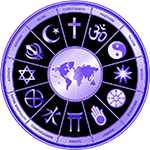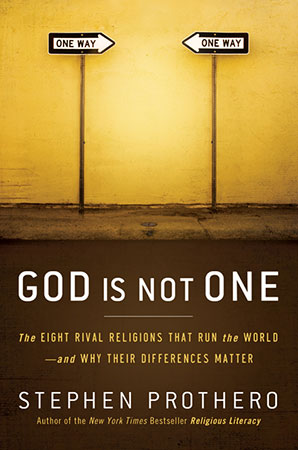[T]here are several different ways in which people of different religions may relate to each other. Diana Eck is one of the scholars who have observed that there are three responses to contact between religions.
One
is exclusivism: “Ours is the only true way.” Eck
and others
have noted
that deep personal commitment
to
one’s faith is a foundation of religious life and also the first
essential
step in interfaith dialogue.
 Inclusivism
Inclusivism




|
Part V: Religion in the Twenty-First Century
15 points
Write an essay-style
response to the following question.
Diana Eck speaks of three responses that may be
adopted when one comes into contact with religious traditions other than one’s
own: exclusivism,
inclusivism, and pluralism. Describe these three responses, noting what you regard
as the strengths and weaknesses of each approach. Identify the response that
most closely approximates your own perspective on the question of religious
diversity, justifying your answer in terms of the strengths and weaknesses
referred to above. How does your perspective on religious diversity affect your
ability to study and learn from religious traditions other than your own? Provide
at least one example from the material covered in this course to illustrate
your answer. Conclude your essay with a paragraph on what you have learned
about the study of religion in this course. |
|

The Unity of the Ultimate Source?
All
religions meditate
on the Source.
And yet, strangely, religion is one of our
greatest
divides.
 If the Source be the same, as indeed it must be, all of
us
and all religions meditate on the same Source.(Wangari Maathai: Living Religions, 507)
If the Source be the same, as indeed it must be, all of
us
and all religions meditate on the same Source.(Wangari Maathai: Living Religions, 507)
|

 |
|
Is the Mountain One or Many?
At least since the
first petals of the counterculture bloomed across Europe and the United
States in the 1960s, it has been fashionable to affirm that all
religions are beautiful and all are true. ... The most popular metaphor
for this view portrays the great religions as different paths up the
same mountain. “It is possible to climb life’s mountain from any side,
but when the top is reached the trails converge,” writes philosopher of
religion Huston Smith. “At base, in the foothills of theology, ritual,
and organizational structure, the religions are distinct. Differences
in culture, history, geography, and collective temperament all make for
diverse starting points. ... But beyond these differences, the same
goal beckons.” ... According to Mohandas Gandhi, “Belief in one God is the cornerstone of all religions,” so it is toward this one God that all religious people are climbing. ... Like Gandhi, the Dalai Lama affirms that “the essential message of all religions is very much the same.” In his view, however, what the world’s religions share is not so much God as the Good —
the sweet harmony of peace, love, and understanding that religion
writer Karen Armstrong also finds at the heart of every religion. ...

This is a lovely
sentiment but it is dangerous, disrespectful, and untrue. For more than
a generation we have followed scholars and sages down the rabbit hole
into a fantasy world in which all gods are one. This wishful thinking
is motivated in part by an understandable rejection of the exclusivist
missionary view that only you and your kind will make it to heaven or
Paradise. For most of world history, human beings have seen religious
rivals as inferior to themselves — practitioners of empty rituals,
perpetrators of bogus miracles, purveyors of fanciful myths. The Age of
Enlightenment in the eighteenth century popularized the ideal of
religious tolerance, and we are doubtless better for it. But the idea
of religious unity is wishful thinking nonetheless, and it has not made
the world a safer place. In fact, this naive theological groupthink —
call it Godthink — has made the world more dangerous by blinding us to
the clashes of religions that threaten us worldwide. It is time we
climbed out of the rabbit hole and back to reality. (God is not One, Introduction)
|

|


